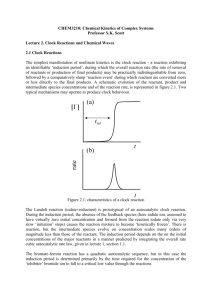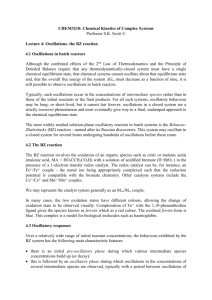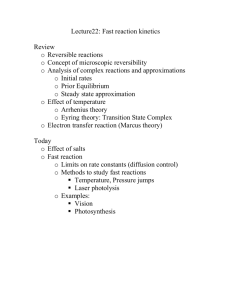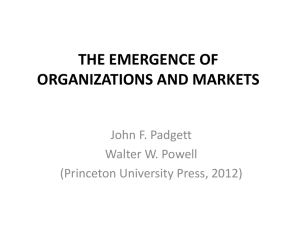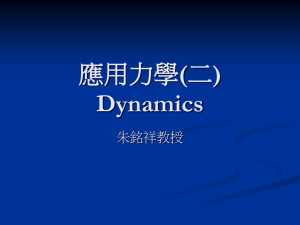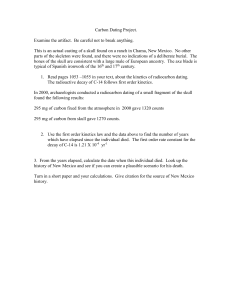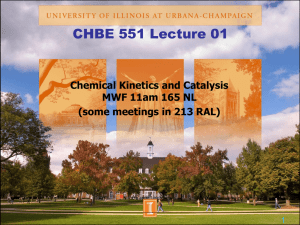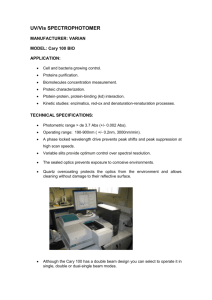NONLINEAR REACTIONS, FEEDBACK AND SELF
advertisement
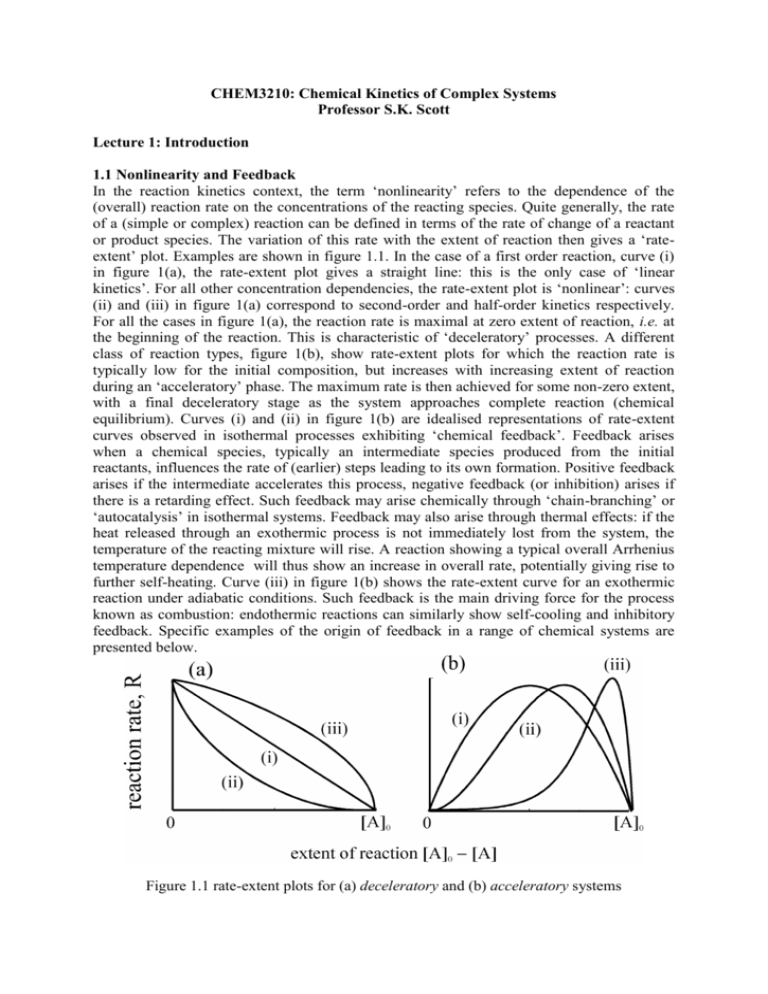
CHEM3210: Chemical Kinetics of Complex Systems Professor S.K. Scott Lecture 1: Introduction 1.1 Nonlinearity and Feedback In the reaction kinetics context, the term ‘nonlinearity’ refers to the dependence of the (overall) reaction rate on the concentrations of the reacting species. Quite generally, the rate of a (simple or complex) reaction can be defined in terms of the rate of change of a reactant or product species. The variation of this rate with the extent of reaction then gives a ‘rateextent’ plot. Examples are shown in figure 1.1. In the case of a first order reaction, curve (i) in figure 1(a), the rate-extent plot gives a straight line: this is the only case of ‘linear kinetics’. For all other concentration dependencies, the rate-extent plot is ‘nonlinear’: curves (ii) and (iii) in figure 1(a) correspond to second-order and half-order kinetics respectively. For all the cases in figure 1(a), the reaction rate is maximal at zero extent of reaction, i.e. at the beginning of the reaction. This is characteristic of ‘deceleratory’ processes. A different class of reaction types, figure 1(b), show rate-extent plots for which the reaction rate is typically low for the initial composition, but increases with increasing extent of reaction during an ‘acceleratory’ phase. The maximum rate is then achieved for some non-zero extent, with a final deceleratory stage as the system approaches complete reaction (chemical equilibrium). Curves (i) and (ii) in figure 1(b) are idealised representations of rate-extent curves observed in isothermal processes exhibiting ‘chemical feedback’. Feedback arises when a chemical species, typically an intermediate species produced from the initial reactants, influences the rate of (earlier) steps leading to its own formation. Positive feedback arises if the intermediate accelerates this process, negative feedback (or inhibition) arises if there is a retarding effect. Such feedback may arise chemically through ‘chain-branching’ or ‘autocatalysis’ in isothermal systems. Feedback may also arise through thermal effects: if the heat released through an exothermic process is not immediately lost from the system, the temperature of the reacting mixture will rise. A reaction showing a typical overall Arrhenius temperature dependence will thus show an increase in overall rate, potentially giving rise to further self-heating. Curve (iii) in figure 1(b) shows the rate-extent curve for an exothermic reaction under adiabatic conditions. Such feedback is the main driving force for the process known as combustion: endothermic reactions can similarly show self-cooling and inhibitory feedback. Specific examples of the origin of feedback in a range of chemical systems are presented below. Figure 1.1 rate-extent plots for (a) deceleratory and (b) acceleratory systems The branching cycle involving the radicals H, OH and O in the H2+O2 reaction involves the three elementary steps H + O2 OH + O O + H2 OH + H OH + H2 H2O + H (1.1) (1.2) (1.3) In steps (1) and (2) there is an increase from one to two ‘chain carriers’. Under typical experimental conditions close to the first and second explosion limits (see elsewhere), steps (2) and (3) are fast relative to the rate determining step (1). Combining (1) + (2) + 2(3) gives the overall stoichiometry H + 3H2 + O2 3H + 2H2O so there is a net increase of 2 H atoms per cycle. The rate of this overall step is governed by the rate of step (1), so we obtain d[H]/dt = +2 k1[O2][H] where the + sign indicates that the rate of production of H atoms increases proportionately with that concentration. In the bromate-iron clock reaction, there is an autocatalytic cycle involving the species intermediate species HBrO2. This cycle is comprised the following non-elementary steps HBrO2 + BrO3 + H+ 2 BrO2 + H2O (1.4) 2+ + 3+ BrO2 + Fe + H HBrO2 + Fe (1.5) Step (5) is rapid due to the radical nature of BrO2, so the overall stoichiometric process given by (4) + 2(5), has the form HBrO2 + BrO3 + 2Fe2+ + 3H+ 2 HBrO2 + 2Fe3+ + H2O and an effective rate law d[HBrO2]/dt = + k4[BrO3][H+][HBrO2] again showing increasing rate of production as the concentration of HBrO2 increases. In ‘Landolt’-type reactions, iodate ion is reduced to iodide through a sequence of steps involving a reductant species such as bisulfite ion (HSO3) or arsenous acid (H3AsO3). The reaction proceeds through two overall stoichiometric processes. The Dushman reaction involves the reaction of iodate and iodide ions IO3 + 5I + 6H+ 3I2 + 3H2O with an empirical rate law R = (k1 + k2[I])[IO3][I][H+]2 (1.6) The iodine produced in the Dushman process is rapidly reduced to iodide via the Roebuck reaction I2 + H3AsO3 + H2O 2I + H3AsO4 + 2H+ (1.7) If the initial concentrations are such that [H3AsO3]0/[IO3]0 > 3, the system has excess reductant. In this case, the overall stoichiometry is given by (6) + 3(7) to give 3H3AsO3 + IO3 + 5I 3H3AsO4 + 6I i.e. there is a net production of one iodide ion, with an overall rate given by R. At constant pH and for conditions such that k2[I] >> k1, this can be approximated by dI / dt kIO-3 I 2 where k = k2[H+]2. This again has the autocatalytic form, but now with the growth proportional to the square of the autocatalyst (I) concentration. Generic representations of autocatalytic processes in the form quadratic autocatalysis cubic autocatalysis A + B 2B A + 2B 3B rate = kab rate = kab2 where a and b are the concentrations of the reactant A and autocatalyst B respectively, are represented in figure A3.15.1(b) as curves (i) and (ii). The bromate-iron reaction corresponds to the quadratic type and the Landolt system to the cubic form. 1.2 Self-Organising Systems ‘Self-organisation’ is a phrase referring to a range of behaviours exhibited by reacting chemical systems in which nonlinear kinetics and feedback mechanisms are operating. Examples of such behaviour include ignition and extinction, oscillations and chaos, spatial pattern formation and chemical wave propagation. There is a formal distinction between thermodynamically closed systems (no exchange of matter with the surroundings) and open systems [1]. In the former, the reaction will inevitably attain a unique state of chemical equilibrium in which the forward and reverse rates of every step in the overall mechanism become equal (detailed balance). This equilibrium state is temporally stable (the system cannot oscillate about equilibrium) and spatially uniform (under uniform boundary conditions). However, nonlinear responses such as oscillation in the concentrations of intermediate species can be exhibited as a transient phenomenon, provided the system is assembled with initial species concentrations sufficiently ‘far from’ the equilibrium composition (as is frequently the case). The ‘transient’ evolution may last for an arbitrary long, but strictly finite, period - even on the geological timescale.
